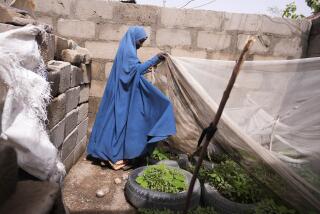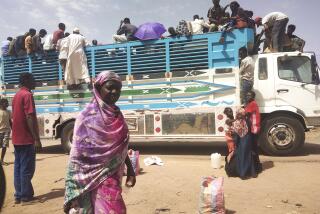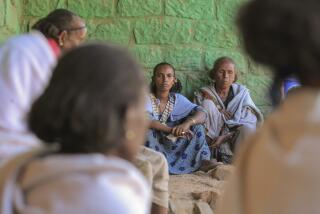Hunger Casts a Deep Shadow Over Malawi
- Share via
KAUNDUMA, Malawi — On most days, Melina Jakasoni’s three small children survive on a single meal of boiled and mashed pumpkin leaves. When her scrounging pays off, the young mother is able to make porridge from donated corn husks. On rare occasions, a neighbor allows her to forage in her yard for groundnuts.
Once again, hunger is stalking Africa.
The calamity here is one piece of a food crisis--partly natural and partly man-made--that is sweeping southern Africa. It is biting in every household of this dusty settlement about 18 miles from Lilongwe, the country’s capital.
“This year has been very terrible for me,” said Jakasoni as her scrawny 3-year-old son, Vita, sucked in frustration on her shriveled breasts. “I have even been forced to eat wild roots.”
Medical workers say that since January, 13 of Kaunduma’s 474 residents have died of hunger. Jakasoni’s mother was among them. Her two youngest children are in need of therapeutic feeding. Her oldest child, a 7-year-old, is so gaunt that she could pass for 5.
“This year, I think many more people will die,” said Kenius Mkanda, a local health worker. Malawi, a densely populated country slightly smaller than Pennsylvania, is facing its worst hunger crisis in more than 50 years. About 70% of its 11 million people are in desperate need of food aid, according to government estimates. And that figure is expected to rise. Hundreds of adults and children have died of hunger-related illnesses since December, aid workers say.
Severe flooding in some parts of the country, coupled with drought in others, has slashed crop yields in the last several years. Although April’s harvest of corn has brought temporary relief, the yield was small. Experts and government officials predict that most families’ food stocks will run out by August.
“It’s unthinkable what might happen if food is not available by the time it is needed,” said Chigomezgo Mtegha, an assistant program officer for the U.N. World Food Program in Malawi.
The agency is preparing to launch an emergency operation to get food to about 2 million people by September.
“Right now, people are eating from their [unripe] gardens in many parts of the country,” said Lucius Chikuni, Malawi’s commissioner for disaster preparedness, relief and rehabilitation. “They have sold their assets. They are completely overstretched when it comes to coping mechanisms.”
As bad as things are here, Malawi is only one part of a larger problem.
In neighboring Zimbabwe, which is suffering from both drought and the effects of President Robert Mugabe’s land-redistribution policies, about 3 million people will need daily food aid starting this month, according to the Washington-based Famine Early Warnings Systems Network, which monitors food supplies.
Drought and floods have caused food shortages for more than 1.2 million of Zambia’s 10 million people. Lesotho’s prime minister recently declared that the country was starving, while in Swaziland, the government says more than 150,000 of its 1 million citizens are facing severe hunger.
The scourge of AIDS is compounding the food crisis. An estimated 15% to 20% of the adult population in southern Africa is HIV-positive. Riddled with disease, many of them are unable to find jobs or till their fields.
Older Malawians say they have not seen such hunger since 1949, widely considered the year of the country’s worst famine. And even those days seem less catastrophic than now.
“In 1949, we had somewhere to buy food, and we got handouts from the government,” recalled Shoes Namitambo, chief of Nthumba village in the southern part of the country, one of the hardest-hit regions. “This year the problem is, there is nothing to buy, and if there is, we can’t afford it.”
The official price of corn has increased nearly 400% to about $7 for a 110-pound bag, a fortune in a country where 60% of people survive on $1 a day.
Nthumba, a community of 74 households, has lost three people to hunger since November. Three others fell prey to crocodiles as they tried to pluck water lily roots, a poor substitute for green vegetables, from the nearby Shire River.
But the biggest tragedy, aid workers, diplomats and donors say, is that the situation never should have become this bad.
In addition to climatic factors, donors say the crisis is the consequence of bad management of Malawi’s grain reserves, logistics problems with importing corn, and the vicious circle of poverty that leaves people too poor to buy food, seeds and fertilizer. In 2000, Malawi was ranked 163rd out of 174 countries on a U.N. list that rated countries on prosperity and development.
Donors accuse the government of mismanaging the country’s food stocks by selling off nearly 167,000 tons of surplus grain last year.
The government argues that some of the grain was going bad and that Western donors pushed it to sell the reserve, insisting that it was too expensive to store. Officials in Lilongwe also blame donors for cutting funding to a program that was providing free seeds and fertilizer to needy families.
Donors counter that they urged Malawi to sell old corn in its reserves before it rotted and then buy new reserves, reducing the grain stock--but not down to zero.
Evidence of bad governance, corruption and overspending have made donors less sympathetic.
“A lot of the donors are frustrated, especially when they feel the government is partly to blame,” said Kerren Hedlund, head of the World Food Program’s Vulnerability Analysis and Mapping Unit in Malawi. “They feel this situation should not have happened.”
Paul Ginies, a Lilongwe-based advisor for the European Commission, said that flooding the country with donated food is not the answer to Malawi’s woes, since this would undermine the local market, slashing the price of corn to levels at which small-scale farmers could no longer compete.
Some donors wonder whether Malawi is suffering from an overall food shortage, or just a shortage of corn, its staple crop.
Maurizio Borzini, an economic diversification specialist with the European Commission, said that other crops such as cassava, sweet potato and rice are available in most parts of the country, but that most people do not feel that they have eaten a proper meal unless it includes corn.
“There is a difficult food situation, this is clear,” Borzini said. “But to quantify the gap between the needs and the availability, that is the problem.”
Government officials acknowledge that the country’s agricultural policy is biased toward corn. But they argue that certain crops, like cassava, only grow well in some parts of the country and do not store well. Furthermore, corn is the most popular choice.
“We know that our people should diversify their dietary habits,” said Chikuni, the relief official. “But telling the average Malawian not to eat maize flour, eat something else, is like telling a Chinese person not to eat rice.”
In rural areas, some schools have closed because of the food shortages. Scores of students have dropped out.
Among such children is 12-year-old Madalitso Kachepa of Kaunduma. She and her four younger siblings stopped attending school last year. It was just too hard to study on a single daily meal of boiled pumpkin leaves.
“We’re still hungry when we go to sleep,” Madalitso lamented.
Her mother, Titheranji, didn’t plant anything this year. She couldn’t find a job that would bring in the money she needed to buy seeds. She has lost hope.
“I cannot even plan what I can do for my family, not for next week, or for next month,” she said as her scaly 3-year-old son, Saidi, clutched at her breast, his bloated belly protruding. “I really don’t know what’s going to happen.”
In despair, many families have resorted to selling off their meager belongings. Almost all households in Nthumba have had to sell firewood or livestock to buy grain. Many slash their asking prices just to make a sale.
A goat, for example, used to sell for about $7. Hungry people, who don’t own freezers to store meat, are now willing to sell their livestock for as little as $1.50. Instead of buying corn by the bag, most people can afford to buy only a mug full, costing about 3 cents, at a time, said Namitambo, the chief.
Desperation has also led to stealing, and vigilantism is on the rise.
Two people in Kaunduma have been killed since January because they stole crops, said Mkanda, the health care specialist, who also has had crops stolen. Many farmers have taken to sleeping in their fields to guard their scant produce.
The government says that it is pulling out all stops in an effort to avert famine.
Chikuni said plans are being made to contract commercial farmers--who normally grow tobacco, tea or sugar cane--to grow corn, the first such endeavor in Malawi’s history. Ways are being sought to offer affordable credit to farm families to allow them to buy seed and fertilizer.
But this help will come too late for many Malawians.
In the pediatric ward at Lilongwe’s Central Hospital, mothers clutch and pray over infants who display the classic traits of malnutrition: swollen stomachs, withered limbs, bulging, listless eyes, and wispy, yellowing hair.
Some will bear the physical scars of undernourishment for the rest of their lives. Many will not live to see next year’s harvest.
The children’s ward has 60 patients. Doctors are bracing for many more.
More to Read
Sign up for Essential California
The most important California stories and recommendations in your inbox every morning.
You may occasionally receive promotional content from the Los Angeles Times.











